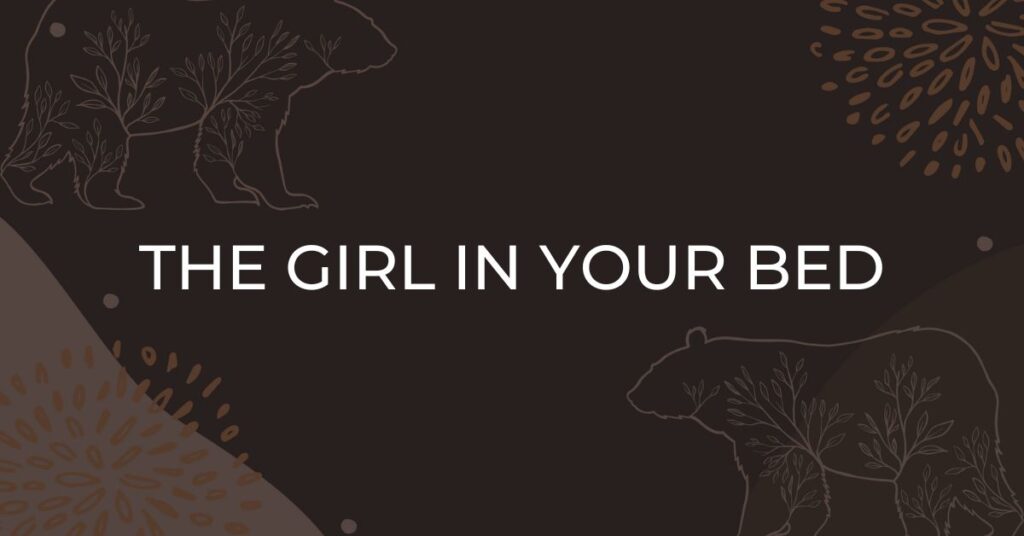
A short interactive fiction game created with Twine. The project strengthened my understanding of creating an engaging narrative experience through a compact, choice-driven branching structure.
Brief
I created this game as part of Susan O’Connor’s Game Writing Masterclass. The brief was to work with an existing narrative – a fairy tale – and design a playable experience using that as a basis. I’d just finished playing a game called Ravenlok when I began working on this, so fairytale-based thematics were quite fresh in my mind. Below are some insights into my creative process, along with some of the design decisions I made about the game. I’ve tried to keep things brief in this post, but for a more detailed breakdown, you can play the game itself and explore the creative notes in the sidebar.
Play The Girl In Your Bed
creative process
This is the basic workflow I followed to create my game from its initial concept to completion.
Side note: these images are taken from my game writing journal and large paper plans. With that in mind, please overlook my handwriting – my brain works faster than my hand can neatly keep up with on paper!
- Research
- I examined my existing knowledge and understanding of fairytales. To explore variations and retellings, I revisited several children’s books and fairytale collections. This helped me find a narrative that was consistently present in children’s literature.
- Early ideas
- I made a list of potential fairytales to work with. Then, I explored which one had the best foundations as a playable experience and could give me a malleable plot. I wanted to work with a story experience that would make sense with certain mechanics, such as exploration, investigation, character dialogue interactions etc.
- After some deliberation, I settled on Goldilocks and the Three Bears. It’s the story that stood out to me as being one of the most unexplored and potentially emotionally compelling to work with as a game.
- Establish a narrative concept
- I listed all of the different themes and questions running through the story. Exploring the key thematic concepts that underpin the original story felt like an authentic starting point for establishing a direction for my own game.
- This gave me the idea of reframing the narrative away from Goldilocks as the main character. Instead, what if the game explored events through the eyes of the character who was most victimised by what she did?
- Choose a player character
- I listed the pros and cons for each character option. Then, I planned out the game with three different story stacks depending on which character would be the player character. This helped me to identify which character’s viewpoint resonated most strongly and had an emotionally interesting core concept.
- I also planned various actions, and ideas for the game’s economy and story beats based on each potential character.
- I chose Baby Bear as the player character based on the story stack explorations.

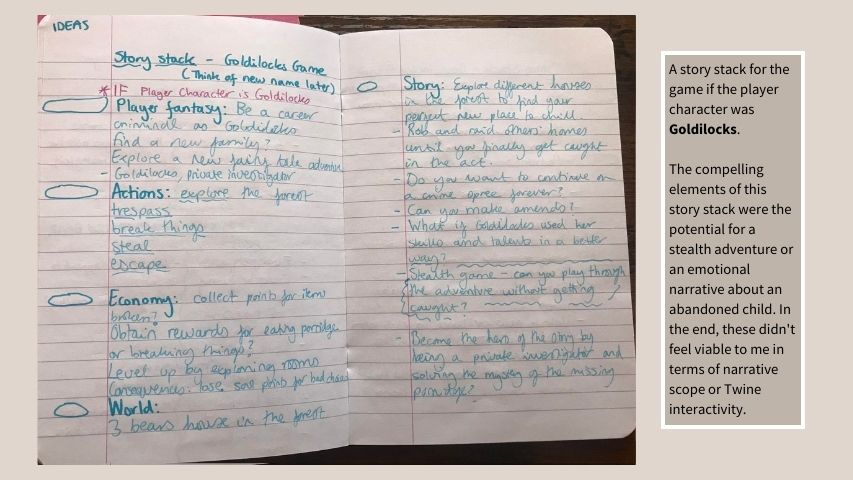


- Design narrative outline
- Based on Baby Bear’s story stack, I plotted an outline for the game. This was originally quite long and complex but gave an overview of the game narrative from start to finish.
- I then mapped this out as a paper prototype so that I could see the player’s journey and possible narrative branches.
- This highlighted the overall scope of my concept, which at that point I realised was way too big. To be sure of this, I recreated the paper map in Twine.
- After designing as far as the end of the first section of the game, I decided to bring in some playtesters.
- Playtesting and feedback
- The feedback from my initial work was really useful and positive. However, after thinking it over for a couple of days, I decided to pull back from the longer version of the game and completely revise it into something much smaller.
- Redesign narrative structure
- At this point, I knew I needed to pare back the concept and structure of my game narrative and its potential outcomes. To better understand compact game narratives, I researched some articles online about effective branching structures for shorter, impactful Twine games and took it from there.
- I drew some new maps out on paper and then blocked out a shorter, but twistier turn of events that followed that structure closely.
- I now had a new, smaller version of the game, but with choices that propelled the action into much more valuable and character-driven territories.
- Writing and editing prose in Twine
- With a completed paper prototype, I then mapped things out in Twine. I created the map and choices first, so that the structure was there for me to work within, rather than trying to draft everything passage by passage.
- Once the structure was in place, I started drafting and editing the story’s prose, tweaking and iterating as needed.
- Playtesting and feedback
- Another round of playtesting at this point provided more helpful feedback. It definitely seemed that I was on the right track with this second version of the game, so I continued to develop the action and storytelling within the passages.
- Iteration based on feedback
- The playtesters responded really positively to the choice of protagonist and the early characterisation of Goldilocks/the intruder, so I then took some time to further develop those aspects.
- I also worked on additional character and dialogue development with the Bear family within the passages, based on feedback.
- Work on design, add systems and functions in Twine
- I then started to focus more on the visual design and mechanics of the game. I read a lot of Twine tutorials, specifically on the use of macros, and used these to add effects and an achievements system into the game.
- I also found a customisable template for the visual style of the game, which I’ve used and adapted to create a suitable aesthetic for the experience.
- Credits for the original template and externally sourced macros for gameplay functions are listed in the game’s credits list.
- Playtesting and feedback
- The game then went out for a third round of playtesting, which provided me with some really positive feedback and ideas for additional development.
design decisions And Paper Prototypes
An overview of my early narrative design for the game, along with the redesign of the structure based on the decisions I made to cut back on both the design and the concept.
“Goldilocks Game” version 1:
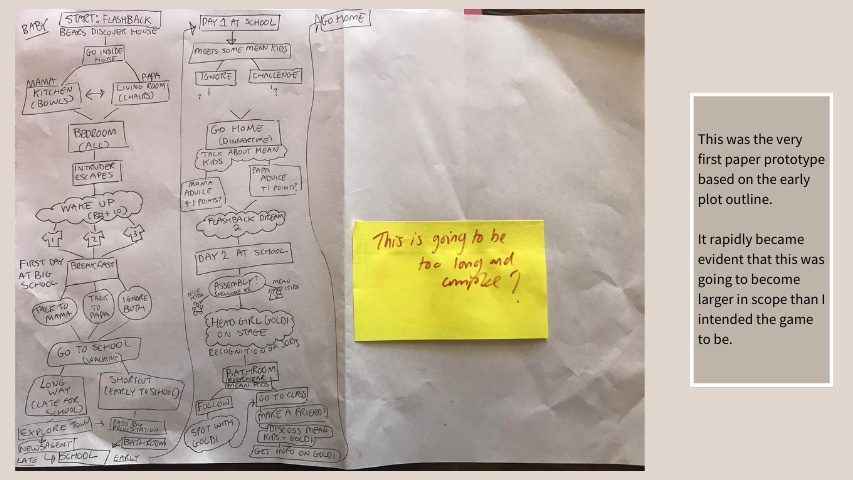
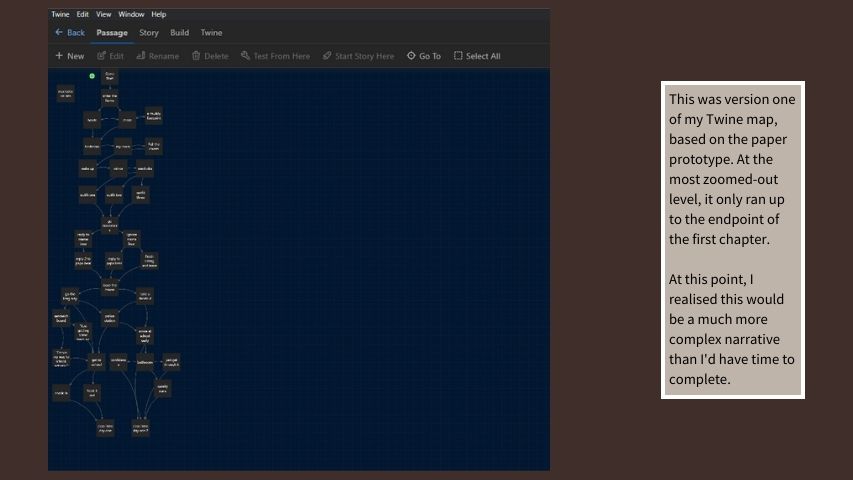
Version 2 – The Girl In Your Bed:

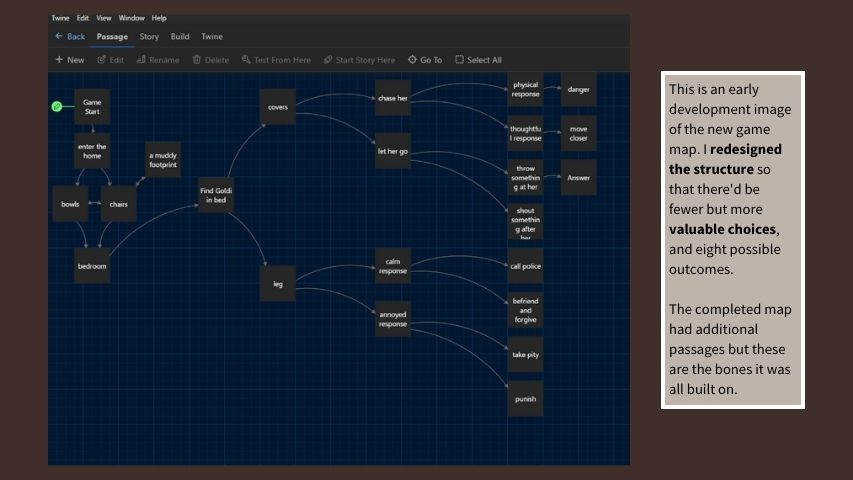
What this project taught me
From start to finish, this game took me around three weeks to design and complete. I wasn’t working on it full-time, but I was able to strategically focus on the development process necessary to turn the game from a concept into a completed playable experience.
Specifically, I believe this project taught me a great deal about the importance of narrative structure, especially in branching narrative work. In particular, I feel that I learned how beneficial it is to approach storytelling in games from a design-first perspective.
It’s also been a lesson in the value of keeping things concise but progressive. The impact of keeping things small but impactful really hit home for me on this project, and is something I’ll aim to implement in future experiences I design.
Having a strong overview of the narrative structure of this game gave me a chance to fine-tune the player’s journey through each of its branches. This helped me focus on the writing of each part of the experience with much greater clarity, as I knew where each decision would lead before I’d actually written it out.